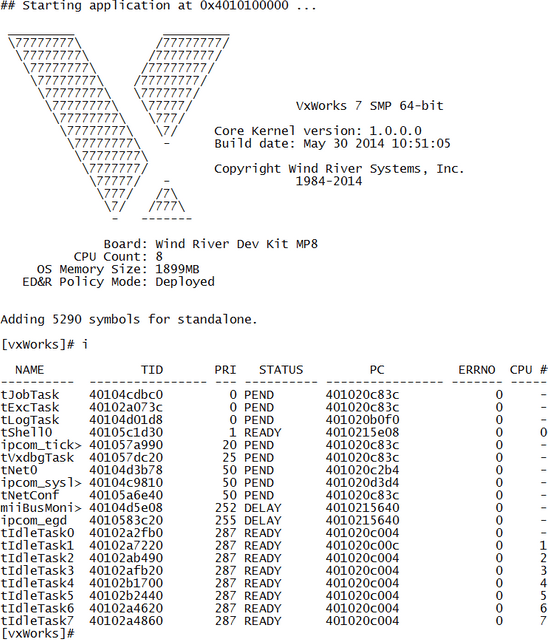VxWorks

VxWorks

 | |
| Developer | Wind River (a wholly owned subsidiary of TPG Capital) |
|---|---|
| OS family | Real-time operating systems |
| Working state | Current |
| Initial release | 1987 (1987) |
| Latest release | 7 / March 2014 (2014-03) |
| Marketing target | Embedded systems |
| Platforms | x86 (including Intel Quark), x86-64, MIPS, PowerPC, SH-4, ARM |
| Kernel type | Monolithic |
| License | Proprietary |
| Official website | Windriver.com/products/vxworks [116] |
VxWorks is a real-time operating system (RTOS) developed as proprietary software by Wind River Systems, a wholly owned subsidiary of TPG Capital, US. First released in 1987, VxWorks is designed for use in embedded systems requiring real-time, deterministic performance and, in many cases, safety and security certification, for industries, such as aerospace and defense, medical devices, industrial equipment, robotics, energy, transportation, network infrastructure, automotive, and consumer electronics.[1]
VxWorks comes with the kernel, middleware, board support packages, Wind River Workbench development suite and complementary third-party software and hardware technologies. In its latest release, VxWorks 7, the RTOS has been re-engineered for modularity and upgradeability so the OS kernel is separate from middleware, applications and other packages.[6] Scalability, security, safety, connectivity, and graphics have been improved to address Internet of Things (IoT) needs.[7][8][9]
 | |
| Developer | Wind River (a wholly owned subsidiary of TPG Capital) |
|---|---|
| OS family | Real-time operating systems |
| Working state | Current |
| Initial release | 1987 (1987) |
| Latest release | 7 / March 2014 (2014-03) |
| Marketing target | Embedded systems |
| Platforms | x86 (including Intel Quark), x86-64, MIPS, PowerPC, SH-4, ARM |
| Kernel type | Monolithic |
| License | Proprietary |
| Official website | Windriver.com/products/vxworks [116] |
History
VxWorks started in the late 1980s as a set of enhancements to a simple RTOS called VRTX[10] sold by Ready Systems (becoming a Mentor Graphics product in 1995).[11] Wind River acquired rights to distribute VRTX and significantly enhanced it by adding, among other things, a file system and an integrated development environment. In 1987, anticipating the termination of its reseller contract by Ready Systems, Wind River developed its own kernel to replace VRTX within VxWorks.[12]
VxWorks key milestones are:[13]
Platform overview
The VxWorks consists of a set of runtime components and development tools. The run time components are an operating system (UP and SMP; 32- and 64-bit), software for applications support (file system, core network stack, USB stack and inter-process communications) and hardware support (architecture adapter, processor support library, device driver library and board support packages).[5] VxWorks core development tools are compilers such as Diab, GNU, and Intel C++ Compiler (ICC)) and its build and configuration tools. The system also includes productivity tools such as its Workbench development suite and Intel tools and development support tools for asset tracking and host support.[5]
The platform is a modular, vendor-neutral, open system that supports a range of third-party software and hardware. The OS kernel is separate from middleware, applications and other packages,[8] which enables easier bug fixes and testing of new features.[14] An implementation of a layered source build system allows multiple versions of any stack to be installed at the same time so developers can select which version of any feature set should go into the VxWorks kernel libraries.
Optional advanced technology for VxWorks provides add-on technology-related capabilities, such as:
Advanced security features to safeguard devices and data residing in and traveling across the Internet of Things (IoT)
Advanced safety partitioning to enable reliable application consolidation
Real-time advanced visual edge analytics allowing autonomous responses on VxWorks-based devices in real time without latency
Optimized embedded Java runtime engine enabling the deployment of Java applications
Virtualization capability with a real-time embedded, Type 1 hypervisor
Features
Multitasking kernel with preemptive and round-robin scheduling and fast interrupt response
Native 64-bit operating system (only one 64-bit architecture supported: x86-64). Data model: LP64.
User-mode applications ("Real-Time Processes", or RTP) isolated from other user-mode applications as well as the kernel via memory protection mechanisms.
SMP, AMP and mixed mode multiprocessing support
Error handling framework
Bluetooth, USB, CAN protocols, Firewire IEEE 1394, BLE, L2CAP, Continua stack, health device profile
Binary, counting, and mutual exclusion semaphores with priority inheritance
Local and distributed message queues
POSIX PSE52 certified conformity in user-mode execution environment
File systems: High Reliability File System (HRFS), FAT-based file system (DOSFS), Network File System (NFS), and TFFS
Dual-mode IPv6 networking stack with IPv6 Ready Logo certification
Memory protection including real-time processes (RTPs), error detection and reporting, and IPC
Multi-OS messaging using TIPC and Wind River multi-OS IPC
Symbolic debugging
Modular, componentized architecture using a layered build system with the ability to update each layer of code independently
VxWorks microkernel (a full RTOS that can be as small as 20 KB)
Security features such as digitally-signed modules (X.509), encryption, password management, ability to add/delete users at runtime
SHA-256 hashing algorithm as the default password hashing algorithm
Human machine interface with Vector Graphics, and Tilcon user interface (UI)
Graphical user interface (GUI): OpenVG stack, Open GL, Tilcon UI, Frame Buffer Driver, EV Dev Interface
Updated configuration interfaces for VxWorks Source Build VSB projects and VxWorks Image Projects
Single authentication control used for Telnet, SSH, FTP, and rlogin daemons
Connectivity with Bluetooth and SocketCAN protocol stacks
Inclusion of MIPC File System (MFS) and MIPC Network Device (MND)
Networking features with 64-bit support including Wind River MACsec, Wind River's implementation of IEEE 802.1A, Point-to-Point Protocol (PPP) over L2TP, PPP over virtual local area network (VLAN) and Diameter secure key storage
New Wind River Workbench 4 for VxWorks 7 integrated development environment with new system analysis tools
Wind River Diab Compiler 5.9.4; Wind River GNU Compiler 4.8; Intel C++ Compiler 14 and Intel Integrated Performance Primitives (IPP) 8
Hardware support
VxWorks has been ported to a number of platforms and now runs on practically any modern CPU that is used in the embedded market. This includes the Intel x86 family (including the Intel Quark SoC),[19] MIPS, PowerPC (and BAE RAD), Freescale ColdFire, Intel i960, SPARC, Fujitsu FR-V, SH-4 and the closely related family of ARM, StrongARM and xScale CPUs.[2] VxWorks provides a standard board support package (BSP) interface between all its supported hardware and the OS. Wind River's BSP developer kit provides a common application programming interface (API) and a stable environment for real-time operating system development. VxWorks is supported by popular SSL/TLS libraries such as wolfSSL.[20]
Development environment
As is common in embedded system development, cross-compiling is used with VxWorks. Development is done on a "host" system where an integrated development environment (IDE), including the editor, compiler toolchain, debugger, and emulator can be used. Software is then compiled to run on the "target" system. This allows the developer to work with powerful development tools while targeting more limited hardware. VxWorks uses the following host environments and target hardware architectures:[2][21]
- Supported target architectures and processor families
VxWorks supports the following target architectures:
ARM
Intel architecture
Power architecture
For the latest target architecture, processors and board support packages, refer to the VxWorks Marketplace: https://marketplace.windriver.com/index.php?bsp&on=locate&type=platform [118]
The Eclipse-based Workbench IDE that comes with VxWorks is used to configure, analyze, optimize, and debug a VxWorks-based system under development.[22] The Tornado IDE was used for VxWorks 5.x[23] and was replaced by the Eclipse-based Workbench IDE for VxWorks 6.x. and later.[21] Workbench is also the IDE for the Wind River Linux,[24] On-Chip Debugging,[25] and Wind River Diab Compiler product lines. VxWorks 7 uses Wind River Workbench 4[26] which updates to the Eclipse 4 base provide full third party plug-in support and usability improvements.
Wind River Simics[27][28] is a standalone simulation tool compatible with VxWorks. It simulates the full target system (hardware and software) to create a shared platform for software development. Multiple developers can share a complete virtual system and its entire state, including execution history. Simics enables early and continuous system integration and faster prototyping by utilizing virtual prototypes instead of physical prototypes.[29]
Notable uses

The Mars Science Laboratory Curiosity rover uses VxWorks

The ASIMO Robot uses VxWorks

AgustaWestland Project Zero uses VxWorks

The Mars Reconnaissance Orbiter uses VxWorks

The Clementine spacecraft used VxWorks
Aerospace and defense
- Spacecraft
The Mars 2020 rover scheduled to launch in 2020
The Mars Reconnaissance Orbiter[31]
The Mars Science Laboratory, also known as the Curiosity rover[32]
NASA Mars rovers (Sojourner, Spirit, Opportunity)[31]
The Deep Space Program Science Experiment (DSPSE) also known as Clementine (spacecraft)[33] Clementine launched in 1994 running VxWorks 5.1 on a MIPS-based CPU responsible for the Star Tracker and image processing algorithms. The use of a commercial RTOS on board a spacecraft was considered experimental at the time
Phoenix Mars lander[34]
The Deep Impact space probe[35]
The Mars Pathfinder mission[36]
The SpaceX Dragon[37]
Aircraft
- Space telescopes
- Others
Automotive
Toshiba TMPV75 Series image recognition SoCs for advanced driver assistance systems (ADAS)[51]
Bosch Motor Sports race car telemetry system[52]
Clarion AX1Android-based automotive In-Vehicle Infotainment system (IVI)[53]
Hyundai Mobis IVI system[54]
Magneti Marelli's telemetry logger and GENIVI®-compliant infotainment system[55]
BMW iDrive system after 2008[31]
Siemens VDO automotive navigation systems[56]
Most of Renault Trucks T, K and C trucks' electronic control units.
European Volkswagen RNS 510 navigation systems.
Consumer electronics
Apple Airport Extreme[31]
Drobo data storage robot[57]
Honda robot ASIMO[58]
Linksys WRT54G wireless routers (versions 5.0 and later)[31]
MacroSystem Casablanca-2 [119] digital video editor (Avio, Kron, Prestige, Claro, Renommee, Solitaire)
Motorola's DCT2500 [120] interactive digital set-top box[59]
Mobile Technika MobbyTalk and MobbyTalk253 phones[60]
ReplayTV home digital video recorder[61]
Industrial
- Industrial robots
- Test and Measurement
- Transportation
- Controllers
Bachmann M1 Controller System[72]
Invensys Foxboro PAC System[73]
National Instruments CompactRIO 901x, 902x 907x controllers[74]
Mitsubishi's C controller[75]
The Experimental Physics and Industrial Control System (EPICS)[76]
Bosch Rexroth Industrial Tightening Control Systems[77]
MCE iBox elevator controller[78]
- Storage systems
External RAID controllers designed by the LSI Corporation/Engenio prior to 2011, now designed by NetApp. And used in RDAC class arrays as NetApp E/EF Series and OEM arrays
Fujitsu ETERNUS DX S3 family of unified data storage arrays
- Imaging
- Others
GrandMA Full-Size and Light Console by MA Lighting[80]
Medical
Varian Medical Systems Truebeam - a radiotherapy device for treating cancer[81]
Olympus Corporation's surgical generator[82]
BD Biosciences FACSCount HIV/AIDS Monitoring System[83]
Fedegari Autoclavi S.p.A. Thema4 process controller[84]
Sirona Dental Systems: CEREC extraoral X-ray CAD/CAM systems[85]
General Electric Healthcare: CT and MRI scanners.
Carl Zeiss Meditec: Humphrey Field Analyzer HFA-II Series
Philips C-Arm Radiology Equipment
Networking and communication infrastructure
Arkoon Network Security appliances[86]
Ubee Interactive's AirWalk EdgePoint[87]
Kontron's ACTA processor boards[88]
QQTechnologies's QQSG[89]
A significant portion of Huawei's telecoms equipment uses VxWorks[90]
BroadLight’s GPON/PON products[91]
Shiron Satellite Communications’ InterSKY
Sky Pilot's SkyGateway, SkyExtender and SkyControl[92]
EtherRaptor-1010 by Raptor Network Technology[93]
CPG-3000 and CPX-5000 routers from Siemens[94]
Nokia Solutions and Networks FlexiPacket series microwave engineering product[95]
Acme Packet Net-Net series of Session Border Controllers[96]
Alcatel-Lucent IP Touch 40x8 IP Deskphones
Avaya ERS 8600[97]
Avaya IP400 Office
Cisco CSS platform
Cisco ONS platform
Ciena Common Photonic Layer
Dell PowerConnect switches that are 'powered by' Broadcom, except latest PCT8100 which runs on Linux platform[98]
Ericsson SmartEdge routers (SEOS 11 run NetBSD 3.0 and VxWorks for Broadcom BCM1480 version 5.5.1 kernel version 2.6)[99]
Hewlett Packard HP 9000 Superdome Guardian Service Processor
Hirschmann EAGLE20 Industrial Firewall[100]
HughesNet/Direcway satellite internet modems
Mitel Networks' MiVoice Business (formerly Mitel Communications Director (MCD)), 3300 ICP Media Gateways and SX-200 and SX-200 ICP.[101]
Motorola Solutions MCD5000 IP Deskset System
Motorola SB5100 cable modem
Motorola Cable Headend Equipment including SEM, NC, OM and other lines
Nortel CS1000 PBX (formerly Nortel Meridian 1 (Option 11C, Option 61C, Option 81C)
Nortel Passport[102]
Radware OnDemand Switches[103]
SonicWALL firewalls[105]
Thuraya SO-2510 satellite phone and ThurayaModule[106]
Radvision 3G communications equipment[107]
3com NBX phone systems[108]
Zhone Technologies access systems
Oracle EAGLE STP system
TCP vulnerability
As of July 2019, a paper published by Armis[109] exposed 11 critical vulnerabilities including remote code execution, denial of service, information leaks, and logical flaws impacting more than 2 billion[110] devices which use the VxWorks RTOS. The findings are significant since this system is in use by quite a few mission-critical products. This YouTube video [121] from Armis[111] shows how an attacker can tunnel into an internal network using the vulnerability and hack into printers, laptops, and any other connected devices. The vulnerability can bypass firewalls as well.[112]





